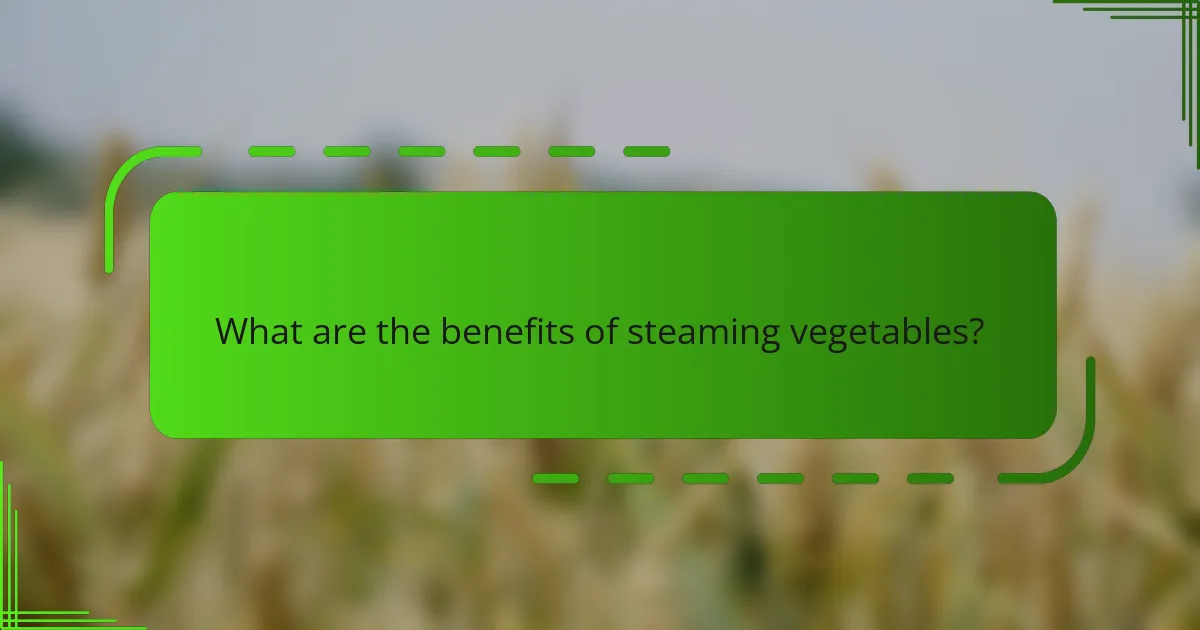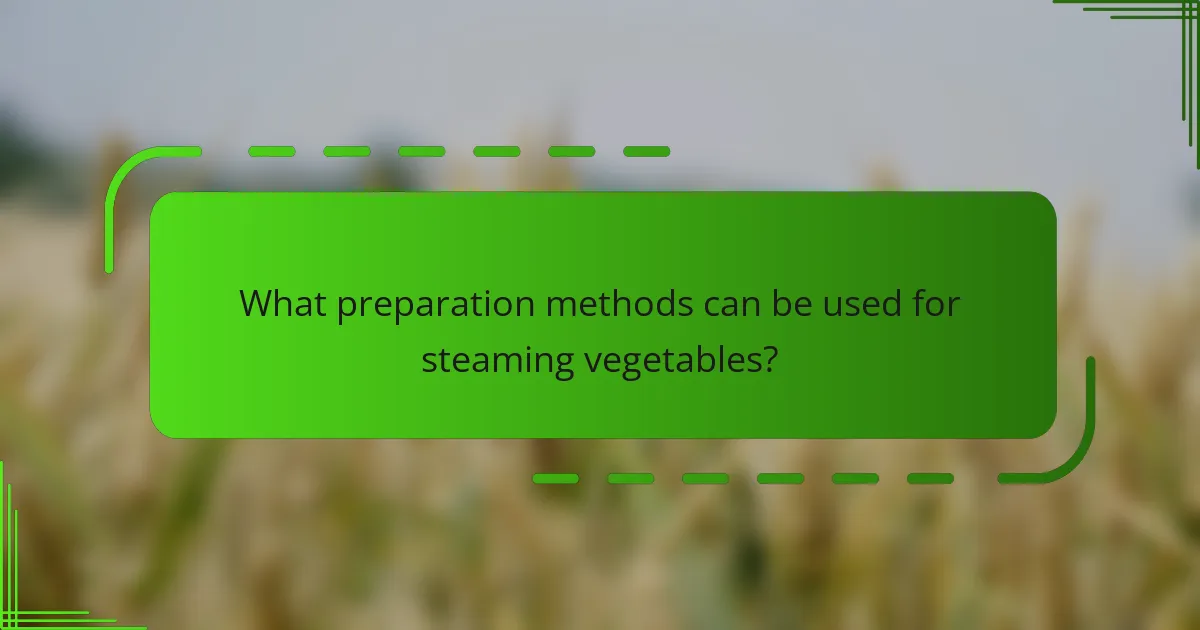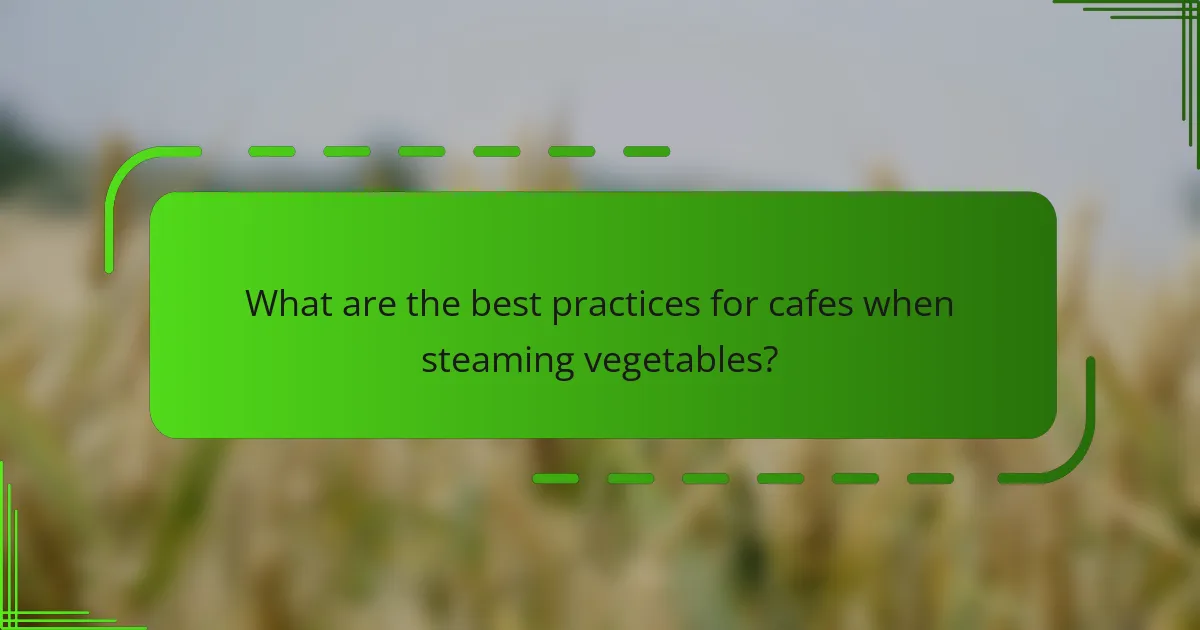Steaming vegetables is a cooking method that effectively preserves nutrients and enhances flavor while minimizing nutrient loss compared to boiling. This technique retains water-soluble vitamins, such as vitamin C and B vitamins, with research indicating up to 90% preservation. The article outlines preparation methods for steaming, including washing, cutting, and blanching vegetables, as well as best practices for cafes to ensure optimal nutrient retention and flavor enhancement. Key recommendations include using fresh produce, maintaining consistent water temperature, minimizing cooking time, and avoiding overcrowding the steamer. Regular cleaning of steaming equipment is also emphasized to uphold food safety standards.

What are the benefits of steaming vegetables?
Steaming vegetables preserves their nutrients and enhances their flavor. This cooking method minimizes nutrient loss compared to boiling. Steamed vegetables retain water-soluble vitamins like vitamin C and B vitamins. Research indicates that steaming can preserve up to 90% of these vitamins. Additionally, steaming helps maintain the natural color and texture of vegetables. This method also reduces the need for added fats or oils, promoting healthier eating. Overall, steaming is an effective way to prepare vegetables while keeping their nutritional value intact.
How does steaming compare to other cooking methods?
Steaming retains more nutrients in vegetables compared to boiling or frying. Boiling often leaches vitamins into the water, while frying can introduce unhealthy fats. Research shows that steaming preserves up to 90% of nutrients. This method uses lower temperatures and shorter cooking times. Steaming also enhances the natural flavors of vegetables. In contrast, methods like roasting can lead to nutrient loss due to higher heat. Overall, steaming is a healthier choice for cooking vegetables.
What impact does steaming have on nutrient retention?
Steaming vegetables positively impacts nutrient retention. This cooking method preserves water-soluble vitamins better than boiling. Steaming reduces nutrient loss by minimizing exposure to water and heat. Research shows that steaming can retain up to 90% of vitamins like C and B. In contrast, boiling may cause a loss of 50% or more of these nutrients. The quick cooking time of steaming further aids in preserving nutrients. Therefore, steaming is an effective method for maintaining the nutritional value of vegetables.
Why is steaming considered a healthier option?
Steaming is considered a healthier option because it preserves more nutrients compared to other cooking methods. When vegetables are steamed, they retain water-soluble vitamins like vitamin C and B vitamins. Boiling, on the other hand, can cause these vitamins to leach into the cooking water. Research shows that steaming can maintain up to 90% of nutrients in vegetables. This method also requires no added fats or oils, making it lower in calories. Additionally, steaming enhances the natural flavors of vegetables, encouraging healthier eating habits. Overall, steaming is an efficient way to prepare vegetables while maximizing their nutritional value.
What specific nutrients are preserved through steaming?
Steaming preserves several specific nutrients in vegetables. Key nutrients retained include vitamin C, B vitamins, and certain antioxidants. Vitamin C is sensitive to heat and water, making steaming effective for retention. B vitamins, such as folate, are also preserved due to reduced cooking time. Antioxidants like carotenoids remain stable during the steaming process. Research shows that steaming can maintain up to 90% of vitamin C content compared to boiling. This method minimizes nutrient loss, enhancing the nutritional profile of steamed vegetables.
How does steaming affect vitamins and minerals in vegetables?
Steaming vegetables preserves more vitamins and minerals compared to boiling. This method reduces nutrient loss by minimizing water contact. Water-soluble vitamins, like vitamin C and B vitamins, are particularly sensitive to heat and water. Steaming typically retains 90-95% of these nutrients. Research from the Journal of Food Science indicates that steaming can maintain higher levels of antioxidants in vegetables. For example, broccoli steamed for just three minutes retains significant levels of sulforaphane, a beneficial compound. Overall, steaming is an effective cooking method for nutrient retention in vegetables.
Which vegetables retain the most nutrients when steamed?
Broccoli, spinach, and carrots retain the most nutrients when steamed. Broccoli contains high levels of vitamin C and sulforaphane, which are preserved during steaming. Spinach retains significant amounts of iron and magnesium when steamed, compared to boiling. Carrots maintain their beta-carotene levels, which are vital for eye health, when steamed. Research shows that steaming vegetables can reduce nutrient loss compared to boiling. A study published in the Journal of Food Science found that steaming can preserve up to 85% of nutrients in certain vegetables. These findings support the benefits of steaming as a cooking method for nutrient retention.

What preparation methods can be used for steaming vegetables?
To steam vegetables, several preparation methods can be utilized. First, washing the vegetables thoroughly removes dirt and contaminants. Next, cutting the vegetables into uniform pieces ensures even cooking. Additionally, blanching vegetables briefly in boiling water can enhance color and texture before steaming. Using a steamer basket or a microwave-safe dish with a lid allows for effective steaming. Finally, adding herbs or spices to the water can infuse flavor during the steaming process. These methods contribute to retaining the nutritional value of the vegetables while achieving optimal texture.
How can vegetables be prepared for steaming?
Wash vegetables thoroughly to remove dirt and pesticides. Cut them into uniform pieces to ensure even cooking. Peel any vegetables that require peeling, such as carrots or potatoes. Remove any inedible parts, like stems or seeds. Blanch vegetables briefly in boiling water for enhanced color and texture. Place the prepared vegetables in a steamer basket or on a steaming tray. Ensure that the water does not touch the vegetables to maintain their nutrients. Cover the steamer to trap steam and cook the vegetables until tender.
What are the best techniques for cutting vegetables before steaming?
The best techniques for cutting vegetables before steaming include uniform slicing, dicing, and julienning. Uniform slicing ensures even cooking, which is crucial for optimal texture and nutrition retention. Dicing vegetables into small cubes can enhance cooking speed and consistency. Julienning, or cutting vegetables into thin strips, allows for quicker steaming and better flavor absorption.
Research indicates that uniform cuts lead to more efficient heat distribution. This method reduces cooking time and preserves nutrients. For example, studies show that steaming broccoli in uniform pieces retains up to 90% of its vitamin C content. Using these cutting techniques optimizes the steaming process, ensuring vegetables are both delicious and nutritious.
How does the size of vegetable pieces affect steaming time?
Smaller vegetable pieces steam faster than larger ones. This is due to the increased surface area of smaller pieces, which allows steam to penetrate and cook them more efficiently. For example, diced carrots will typically steam in about 5-7 minutes, while whole carrots may take 15-20 minutes. The size of the pieces directly influences the cooking time because heat transfer occurs more quickly in smaller portions. Additionally, uniform sizing of vegetable pieces ensures even cooking, preventing some pieces from being undercooked while others are overcooked.
What equipment is needed for steaming vegetables?
A steamer is the primary equipment needed for steaming vegetables. This can be a dedicated electric steamer or a stovetop steamer. A pot with a lid can also be used with a steaming basket or colander. Water is required to create steam. The amount of water depends on the steaming method and duration. A timer helps monitor cooking time for optimal results. A heat source, such as a stove or electric outlet, is necessary to generate steam. These tools ensure that vegetables retain their nutrients and flavor during cooking.
What types of steamers are available for home and commercial use?
There are several types of steamers available for home and commercial use. Home steamers typically include stovetop steamers, electric steamers, and microwave steamers. Stovetop steamers are placed over boiling water on a stove. Electric steamers use electricity to generate steam and often come with multiple tiers for cooking various foods simultaneously. Microwave steamers are designed specifically for use in a microwave, allowing for quick cooking.
Commercial steamers include countertop steamers, combi ovens, and floor-model steamers. Countertop steamers are compact units ideal for small kitchens or food trucks. Combi ovens combine steam and convection cooking, offering versatility for various dishes. Floor-model steamers are larger units suited for high-volume food preparation in restaurants and catering businesses. These steamers often have advanced features for precise cooking control.
How do different steaming devices impact the cooking process?
Different steaming devices affect the cooking process by varying heat distribution and moisture retention. Electric steamers provide consistent heat and humidity, ensuring even cooking. Stovetop steamers often require more attention but can achieve higher temperatures. Microwave steamers cook quickly but may lead to uneven results. Pressure steamers cook food faster due to increased pressure, preserving nutrients effectively. Each device influences cooking time, texture, and flavor of vegetables. Studies show that steaming retains more vitamins compared to boiling, making device choice crucial for nutritional outcomes.

What are the best practices for cafes when steaming vegetables?
The best practices for cafes when steaming vegetables include using fresh produce, maintaining consistent water temperature, and minimizing cooking time. Fresh vegetables retain more nutrients and flavor. Consistent water temperature ensures even cooking. Short cooking times help preserve vitamins and minerals. Cafes should also avoid overcrowding the steamer to allow proper steam circulation. Covering the steamer prevents heat loss and speeds up the cooking process. Regularly cleaning the steaming equipment prevents contamination and maintains food safety standards. Lastly, cafes should experiment with seasoning after steaming to enhance flavor without compromising nutritional value.
How can cafes optimize their vegetable steaming processes?
Cafes can optimize their vegetable steaming processes by using precise temperature control. This ensures vegetables retain their nutrients and flavor. Utilizing steam baskets allows for even cooking and prevents overcrowding. Regularly cleaning steam equipment maintains efficiency and hygiene. Pre-cutting vegetables can reduce cooking time and enhance texture. Implementing timers guarantees consistent cooking durations. Training staff on steaming techniques improves overall quality. Monitoring water levels in steamers prevents overheating and ensures optimal performance.
What are the recommended steaming times for various vegetables?
Recommended steaming times for various vegetables are as follows: Broccoli takes 5-7 minutes. Carrots require 4-6 minutes. Cauliflower needs 5-7 minutes. Green beans take 4-5 minutes. Peas should be steamed for 2-3 minutes. Spinach requires 2-3 minutes. Asparagus takes 3-5 minutes. These times ensure optimal texture and nutrient retention during the steaming process.
How can cafes ensure consistent quality in steamed vegetables?
Cafes can ensure consistent quality in steamed vegetables by standardizing cooking times and temperatures. Implementing precise steaming guidelines helps achieve uniform texture and flavor. Using high-quality, fresh vegetables also contributes to better results. Regularly calibrating steaming equipment ensures accurate performance. Staff training on proper steaming techniques maintains quality control. Monitoring vegetable doneness visually and through timing aids consistency. Keeping a checklist for vegetable preparation can streamline the process. These practices collectively enhance the overall quality of steamed vegetables served in cafes.
What challenges might cafes face when steaming vegetables?
Cafes may face several challenges when steaming vegetables. One major challenge is ensuring consistent cooking times for different vegetable types. Various vegetables have different densities and water content, affecting steaming duration. Another challenge is maintaining the right temperature to prevent overcooking. Overcooked vegetables can lose their nutrients and texture.
Additionally, cafes may struggle with equipment limitations. Not all cafes have commercial-grade steamers capable of handling large quantities efficiently. This can lead to delays during peak hours. Another issue is the potential for flavor loss. Steaming can sometimes result in bland vegetables if not seasoned properly.
Lastly, staff training is crucial. Inexperienced staff may not know the correct steaming techniques, impacting food quality. Proper training ensures that vegetables are steamed to perfection, retaining their nutritional value and appeal.
How can cafes troubleshoot common steaming issues?
Cafes can troubleshoot common steaming issues by checking equipment settings and ensuring proper water levels. Inspect steamers for clogs or damage that may affect performance. Adjust temperature settings to achieve optimal steaming conditions. Regularly clean steamers to prevent buildup that can lead to issues. Use fresh vegetables for better steam absorption and cooking efficiency. Monitor cooking times to avoid undercooking or overcooking. Ensure proper sealing of steamers to maintain pressure and heat. These practices enhance steaming effectiveness and improve vegetable quality.
What are the best strategies for storing steamed vegetables?
The best strategies for storing steamed vegetables include refrigeration and airtight containers. Store steamed vegetables in a refrigerator within two hours of cooking. Use airtight containers to prevent moisture loss and preserve freshness. Label containers with dates for easy tracking. Consume within three to five days for optimal quality. Freezing is another option for long-term storage. Blanch vegetables before freezing to maintain color and texture. Proper storage techniques help retain nutrients and flavor.
What tips can cafes implement for serving steamed vegetables effectively?
Cafes can implement several tips for serving steamed vegetables effectively. First, use fresh vegetables to maximize flavor and nutrition. Steaming should be done just until tender to preserve texture and nutrients. Utilize a steamer basket for even cooking and to prevent overcooking. Season vegetables lightly before steaming to enhance natural flavors. Serve immediately after cooking to maintain warmth and freshness. Consider pairing steamed vegetables with complementary sauces or garnishes for added appeal. Regularly rotate vegetable selections to keep the menu interesting and seasonal. These practices can improve the overall quality and presentation of steamed vegetables in cafes.
The main entity of the article is the benefits of steaming vegetables. The article provides an in-depth analysis of how steaming preserves nutrients, enhances flavor, and promotes healthier eating compared to other cooking methods like boiling and frying. It highlights specific nutrients retained through steaming, preparation methods, and best practices for cafes to optimize their steaming processes. Additionally, it addresses challenges cafes may face when steaming vegetables and offers strategies for troubleshooting and effective storage. Overall, the article serves as a comprehensive guide to the nutritional advantages and practical aspects of steaming vegetables.